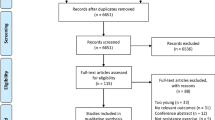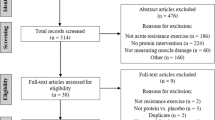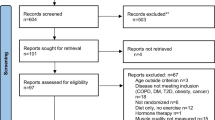Abstract
Vitamin D is important for skeletal muscle health and deficiency is associated with clinical neuromuscular symptoms of poor strength and gait. Supplementation can independently increase muscle strength in chronically deficient populations. However, the regulatory role of vitamin D on neuromuscular remodelling and adaptation subsequent to exercise conditioning or injury has not been systematically reviewed. Objective: to systematically review the available evidence of the role of vitamin D on neuromuscular remodelling following exercise conditioning, exercise- or experimentally induced injury. We searched Medline (OVID platform), PubMed, Embase and Web of Science for randomised controlled trials (RCTs) including measures of neuromuscular function, injury and/or inflammation; a physiologically stressful intervention involving exercise conditioning, exercise- or experimentally induced injury and; vitamin D supplementation. Nine RCTs met the inclusion criteria. Significant heterogeneity of methodological approaches and outcomes meant that meta-analysis of data was limited. Qualitative findings indicated that vitamin D may be an effective accelerant of neuromuscular remodelling in animal models (24–140 % improved recovery vs. control); the effects in humans are inconclusive and likely influenced by baseline vitamin D and supplementation strategy. Results of the meta-analyses indicated no effect of vitamin D supplementation on muscle strength adaptation following resistance training [standardised mean difference (SMD): 0.74, P = 0.42] or muscle damage (SMD: −0.03, P = 0.92), although inflammatory markers were elevated in the latter (SMD: 0.56, P = 0.04). Data from animal models offer promising and plausible mechanisms for vitamin D as an agent for neuromuscular adaptation. Further high-quality research is needed to offer clearer insight into the influential role of vitamin D in human populations.


Similar content being viewed by others
References
Holick MF (2007) Vitamin D deficiency. NEJM 357(3):266–281
Laird E, Ward M, McSorley E, Strain JJ, Wallace J (2010) Vitamin D and bone health: potential mechanisms. Nutrients 2(7):693–724
van Schoor NM, Visser M, Pluijm SMF, Kuchuk N, Smit JH, Lips P (2008) Vitamin D deficiency as a risk factor for osteoporotic fractures. Bone 42(2):6
Hamilton B (2010) Vitamin D and human skeletal muscle. Scand J Med Sci Spor 20(2):182–190
Todd JJ, Pourshahidi LK, McSorley EM, Madigan SM, Magee PJ (2015) Vitamin D: recent advances and implications for athletes. Sports Med 45:213–229
Ceglia L, Harris SS (2013) Vitamin D and its role in skeletal muscle. Calcified Tissue Int 92(2):151–162
Theodoratou E, Tzoulaki I, Zgaga L, Ioannidis JP (2014) Vitamin D and multiple health outcomes: umbrella review of systematic reviews and meta-analyses of observational studies and randomised trials. BMJ 348:g2035
Wacker M, Holick MF (2013) Vitamin D—effects on skeletal and extraskeletal health and the need for supplementation. Nutrients 5(1):111–148
Vitamin D Council (2014) https://www.vitamindcouncil.org/. Accessed Sept 2014
Bischoff-Ferrari HA, Giovannucci E, Willett WC, Dietrich T, Dawson-Hughes B (2006) Estimation of optimal serum concentrations of 25-hydroxyvitamin D for multiple health outcomes. Am J Clin Nutr 84(1):18–28
Annweiler C, Schott AM, Berrut G, Fantino B, Beauchet O (2009) Vitamin D-related changes in physical performance: a systematic review. J Nutr Health Aging 13(10):893–898
Gerdhem P, Ringsberg KA, Obrant KJ, Akesson K (2005) Association between 25-hydroxy vitamin D levels, physical activity, muscle strength and fractures in the prospective population-based OPRA Study of Elderly Women. Osteoporosis Int 16(11):1425–1431
Haroon M, FitzGerald O (2012) Vitamin D deficiency: subclinical and clinical consequences on musculoskeletal health. Curr Rheumatol Rep 14(3):286–293
Redzic M, Lewis RM (2013) Thomas DT. Relationship between 25-hydoxyvitamin D, muscle strength, and incidence of injury in healthy adults: a systematic review. Nutrit Res 33(4):251–258
Tomlinson DJ, Erskine RM, Morse CI, Winwood K, Onambele-Pearson GL (2014) Combined effects of body composition and ageing on joint torque, muscle activation and co-contraction in sedentary women. Age 36(3):9652
Cannell JJ, Hollis BW, Sorenson MB, Taft TN, Anderson JJ (2009) Athletic performance and vitamin D. Med Sci Sport Exer 41(5):1102–1110
Heath KM, Elovic EP (2006) Vitamin D deficiency: implications in the rehabilitation setting. Am J Phys Med Rehab 85(11):916–923
Shinchuk LM, Holick MF (2007) Vitamin D and rehabilitation: improving functional outcomes. Nutr Clin Pract 22(3):297–304
Gallacher SJ, McQuillian C, Harkness M, Finlay F, Gallagher AP, Dixon T (2005) Prevalence of vitamin D inadequacy in Scottish adults with non-vertebral fragility fractures. Curr Med Res Opin 21(9):1355–1361
Cauley JA, Lacroix AZ, Wu L et al (2008) Serum 25-hydroxyvitamin D concentrations and risk for hip fractures. Ann Intern Med 149(4):242–250
Minshull C, Eston R, Rees D, Gleeson N (2012) Knee joint neuromuscular activation performance during muscle damage and superimposed fatigue. J Sport Sci 30(10):1015–1024
Rubenstein LZ (2006) Falls in older people: epidemiology, risk factors and strategies for prevention. Age Ageing 35(Suppl 2):ii37–ii41
Barker T, Henriksen VT, Martins TB et al (2013) Higher serum 25-hydroxyvitamin D concentrations associate with a faster recovery of skeletal muscle strength after muscular injury. Nutrients 5(4):1253–1275
Barker T, Martins TB, Hill HR et al (2014) Vitamin D sufficiency associates with an increase in anti-inflammatory cytokines after intense exercise in humans. Cytokine 65(2):134–137
Kukuljan S, Nowson CA, Sanders K, Daly RM (2009) Effects of resistance exercise and fortified milk on skeletal muscle mass, muscle size, and functional performance in middle-aged and older men: an 18-mo randomized controlled trial. J Appl Physiol 107(6):1864–1873
Ring SM, Dannecker EA, Peterson CA (2010) Vitamin D status is not associated with outcomes of experimentally-induced muscle weakness and pain in young, healthy volunteers. J Nutrit Metab 674240
Shanely RA, Nieman DC, Knab AM et al (2014) Influence of vitamin D mushroom powder supplementation on exercise-induced muscle damage in vitamin D insufficient high school athletes. J Sport Sci 32(7):670–679
Physiotherapy Evidence Database (PEDro) (2014) Retrieved from The George Institute for Global Health. http://www.pedro.org.au/english/downloads/pedro-scale/. Accessed Sept 2014
Chabas JF, Alluin O, Rao G et al (2008) Vitamin D2 potentiates axon regeneration. J Neurotraum 25(10):1247–1256
Chabas JF, Stephan D, Marqueste T et al (2013) Cholecalciferol (vitamin D(3)) improves myelination and recovery after nerve injury. PLoS ONE 8(5):e65034
Choi M, Park H, Cho S, Lee M (2013) Vitamin D3 supplementation modulates inflammatory responses from the muscle damage induced by high-intensity exercise in SD rats. Cytokine 63(1):27–35
Stratos I, Li Z, Herlyn P et al (2013) Vitamin D increases cellular turnover and functionally restores the skeletal muscle after crush injury in rats. Am J Pathol 182(3):895–904
Barker T, Schneider ED, Dixon BM, Henriksen VT, Weaver LK (2013) Supplemental vitamin D enhances the recovery in peak isometric force shortly after intense exercise. Nutr Metab 10(1):69
Bunout D, Barrera G, Leiva L et al (2006) Effects of vitamin D supplementation and exercise training on physical performance in Chilean vitamin D deficient elderly subjects. Exp Gerontol 41(8):746–752
Nieman DC, Gillitt ND, Shanely RA, Dew D, Meaney MP, Luo B (2014) Vitamin D2 supplementation amplifies eccentric exercise-induced muscle damage in NASCAR pit crew athletes. Nutrients 6(1):63–75
Peake JM, Kukuljan S, Nowson CA, Sanders K, Daly RM (2011) Inflammatory cytokine responses to progressive resistance training and supplementation with fortified milk in men aged 50 + years: an 18-month randomized controlled trial. Eur J Appl Physiol 111(12):3079–3088
Wyon MA, Koutedakis Y, Wolman R, Nevill AM, Allen N (2014) The influence of winter vitamin D supplementation on muscle function and injury occurrence in elite ballet dancers: a controlled study. J Sci Med Sport 17(1):8–12
Byrne C, Twist C, Eston R (2004) Neuromuscular function after exercise-induced muscle damage: theoretical and applied implications. Sports Med 34(1):49–69
Gleeson N, Eston RG, Marginson V, McHugh M (2003) Effects of prior concentric training on eccentric exercise induced muscle damage. Br J Sports Med 37(2):119–125
Zerwekh JE (2008) Blood biomarkers of vitamin D status. Am J Clin Nutr 87(4):1087–1091
Heaney RP (2003) Long-latency deficiency disease: insights from calcium and vitamin D. Am J Clin Nutrit 78(5):912–919
Bischoff-Ferrari HA, Borchers M, Gudat F, Durmuller U, Stahelin HB, Dick W (2004) Vitamin D receptor expression in human muscle tissue decreases with age. J Bone Miner Res 19(2):265–26943
Acknowledgments
The authors would like to sincerely thank librarian Mrs Sheila Fisken for her help with setting up the search strategy for this review.
Author Contributions
Author #1 designed and conducted the systematic literature review, analysed the data and prepared the first draft of the paper. She is guarantor. Authors #3 and #4 contributed to the data analysis and systematic review. All authors contributed to and revised the paper critically for intellectual content and approved the final version. All authors agree to be accountable for the work and to ensure that any questions relating to the accuracy and integrity of the paper are investigated and properly resolved.
Author information
Authors and Affiliations
Corresponding author
Ethics declarations
Conflict of Interest
Claire Minshull, Leela C Biant, Stuart H. Ralston, and Nigel Gleeson declare that they have no conflict of interest.
Human and Animal Rights and Informed Consent
This article does not contain any studies with human or animal subjects performed by any of the authors.
Rights and permissions
About this article
Cite this article
Minshull, C., Biant, L.C., Ralston, S.H. et al. A Systematic Review of the Role of Vitamin D on Neuromuscular Remodelling Following Exercise and Injury. Calcif Tissue Int 98, 426–437 (2016). https://doi.org/10.1007/s00223-015-0099-x
Received:
Accepted:
Published:
Issue Date:
DOI: https://doi.org/10.1007/s00223-015-0099-x




